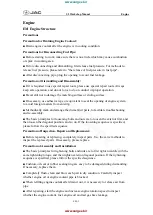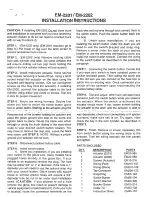
Things to remember when driving
134
Things to remember when driving
Break-in period
Moving parts need breaking-in time to adjust to
each other. To ensure that your vehicle contin-
ues to provide optimized economy of operation
throughout an extended service life, we request
that you devote careful attention to the follow-
ing section.
Engine and differential
Always obey all official speed limits.
Up to 1,200 miles/2,000 km
Drive at changing engine and driving speeds,
however do not exceed 4,500 rpm or 100 mph/
160 km/h.
Avoid full-throttle operation and use of the
transmission's kick-down mode during these
initial miles.
From 1,200 miles/2,000 km
The engine and vehicle speed can gradually be
increased.
Tires
Due to technical factors associated with their
manufacture, tires do not achieve their full trac-
tion potential until after an initial break-in
period. Therefore, drive reservedly during the
first 200 miles/300 km.
Brake system
Brakes require an initial break-in period of
approx. 300 miles/500 km to achieve optimized
contact and wear patterns between brake pads
and rotors. Drive in a reserved manner during
this break-in period.
Clutch
The function of the clutch is only at its opti-
mized level after a distance driven of approx.
300 miles/500 km. During this break-in period,
engage the clutch gently.
Following part replacement
Observe the break-in instructions again if com-
ponents mentioned above must be replaced
after subsequent driving operation.
Saving fuel
The fuel consumption of your vehicle depends
on various factors. Through a few simple steps,
your driving style, and regular maintenance, you
can have a positive influence on your fuel con-
sumption and environmental impact.
Removing unnecessary cargo
Additional weight increases fuel consumption.
Removing add-on parts after use
Remove unneeded auxiliary mirrors, roof or rear
luggage racks after use. Add-on parts attached
to the vehicle impede the aerodynamics and
increase the fuel consumption.
Closing windows and glass sunroof
An open glass sunroof or open windows like-
wise increase the drag coefficient and therefore
the fuel consumption.
Checking tire inflation pressures
regularly
Check and correct the tire inflation pressure as
needed at least twice a month and before long
trips.
An insufficient tire inflation pressure increases
the rolling resistance and thus increases the
fuel consumption and tire wear.
Driving off immediately
Do not allow the engine to warm up by leaving it
running while the vehicle remains stationary.
Instead, begin to drive at a moderate engine
speed. This is the fastest way for the cold
engine to reach its operating temperature.
Online Edition for Part no. 01 41 2 600 721 - © 08/08 BMW AG
Summary of Contents for 2009 5 Series
Page 2: ...Online Edition for Part no 01 41 2 600 721 08 08 BMW AG ...
Page 10: ...Online Edition for Part no 01 41 2 600 721 08 08 BMW AG ...
Page 30: ...Online Edition for Part no 01 41 2 600 721 08 08 BMW AG ...
Page 134: ...Online Edition for Part no 01 41 2 600 721 08 08 BMW AG ...
Page 142: ...Online Edition for Part no 01 41 2 600 721 08 08 BMW AG ...
Page 168: ...Online Edition for Part no 01 41 2 600 721 08 08 BMW AG ...
Page 194: ...Online Edition for Part no 01 41 2 600 721 08 08 BMW AG ...
Page 220: ...Online Edition for Part no 01 41 2 600 721 08 08 BMW AG ...
Page 260: ...Online Edition for Part no 01 41 2 600 721 08 08 BMW AG ...
Page 292: ...Everything from A to Z 290 Online Edition for Part no 01 41 2 600 721 08 08 BMW AG ...
Page 293: ...Online Edition for Part no 01 41 2 600 721 08 08 BMW AG ...
















































